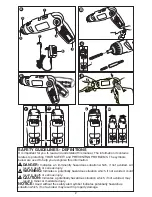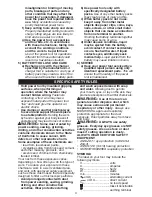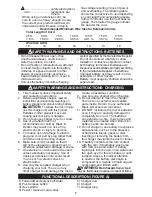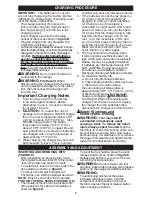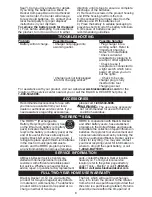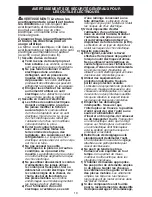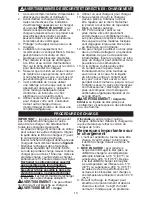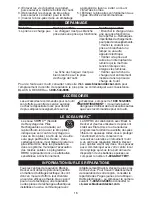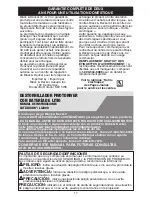
7
OPeRATINg INSTRUCTIONS
• Do not use screwdriver as a pry bar in any
position.
• To avoid screwdriver being turned on
accidentally, do not carry in your pocket.
OPeRATINg IN POWeR MODe
forward
• Rotate the collar (4) to the position marked
as shown in figure f.
• Slide the forward/reverse switch (1) to the
right, exposing the arrow pointing forward
as shown in figure f.
• Press the button on the switch and the tool will
run; release the button and the tool will stop.
Reverse
• Rotate the collar (4) to the position marked
as shown in figure f1.
• Slide the forward/reverse switch (1) to the
left, exposing the arrow pointing backward.
• Press the button on the switch and the tool will
run; release the button and the tool will stop.
fORWARD/ReveRSe/LOCk-Off SLIDeR
• When the forward / reverse slider (1) is in the
central position the tool is locked off to prevent
accidental actuation or battery discharge.
OPeRATINg IN MANUAL MODe
• Rotate the collar to the position marked
as shown in figure g.
• Use the tool as any conventional non-
powered screwdriver. When the forward /
reverse slider (1) is in the central position
the tool is locked off to prevent accidental
actuation or battery discharge.
NOTe: If the collar fails to move past the
cental lock position to manual mode then
please see the following procedure:
1. Turn clutch collar to Power Mode .
(figure g1)
2. Run the unit.
4. Turn clutch collar to Manual Mode .
(figure g1)
SCReW DRIvINg
• Before installing bits, move the forward/ reverse
slider (1) to the center “lock-off” position.
• Insert the appropriate hex shank
screwdriver bit into the spindle.
• Select forward or reverse rotation.
DRILLINg
• Before installing bits, move the forward/ reverse
slider (1) to the center “lock-off” position.
• Insert the appropriate hex shank drill bit.
• Select forward rotation.
NOTe: When drilling, the bit may become
disconnected from the spindle upon
withdrawing it from the material. Should
this occur, the bit can be removed by
re-inserting the hex shank into the spindle
and running the tool in the reverse direction.
geNeRAL DRILLINg TIPS
• This tool is not recommended for drilling
in masonry.
• Use sharp drill bits only.
• Drill bits for metal can be used for drilling
holes in wood. These bits must be sharp
and should be pulled out frequently when
drilling to clear chips from the flutes.
• Support and secure work properly, as
instructed in the safety Instructions.
• Use appropriate and required safety
equipment, as instructed in the safety
instructions.
• Secure and maintain work area, as
instructed in the safety instructions.
• Apply pressure in a straight line with the
bit. Use enough pressure to keep the
bit biting but not so much as to stall the
motor or deflect the bit.
• Hold the tool firmly to control its twisting action.
• DO NOT CLICK THE TRIGGER OF A
STALLED TOOL OFF AND ON IN AN
ATTEMPT TO START IT. DAMAGE TO
THE TOOL CAN RESULT.
• Minimize stalling on breakthrough by
reducing pressure and slowly drilling
through last part of hole.
• Keep the motor running while pulling the bit out
of a drilled hole. This will help reduce jamming.
• Make sure switch turns tool on and off.
WARNINg:
It is important to support
work properly and to hold the tool firmly to
prevent loss of control which could cause
personal injury.
MAINTeNANCe
Use only mild soap and damp cloth to
clean the tool. Never let any liquid get
inside the tool; never immerse any part of
the tool into a liquid.
IMPORTANT: To assure product SAFETY
and RELIABILITY, repairs, maintenance
and adjustment (other than those listed
in this manual) should be performed by
authorized service centers or other qualified
service personnel, always using identical
replacement parts.
This product uses lithium-ion rechargeable
and recyclable batteries. When the batteries
no longer hold a charge, they should be
removed from the product and recycled.
They must not be incinerated or composited.
The batteries can be taken for disposal
to a Black & Decker, Company-Owned
or Authorized Service Center. Some
local retailers are also participating in a
national recycling program (see “RBRC™
BATTeRy ReMOvAL AND DISPOSAL
Summary of Contents for LI2000
Page 26: ...26 ...


